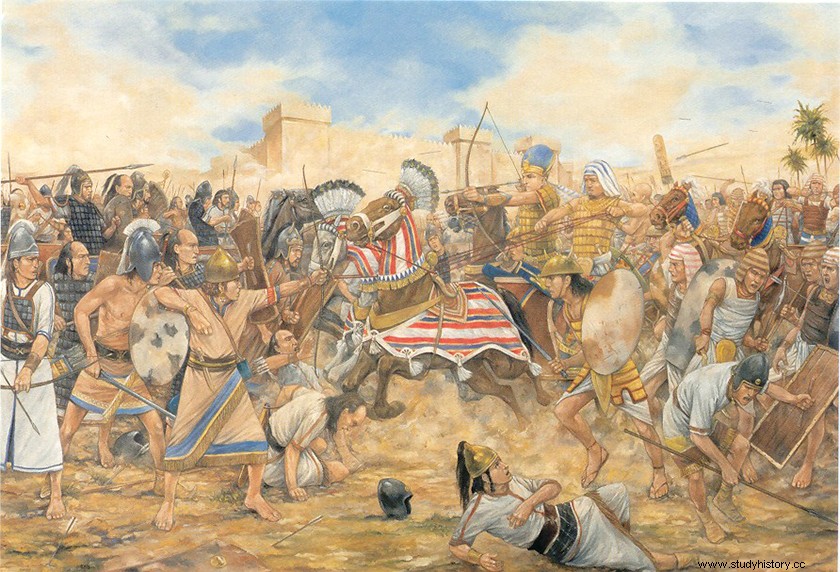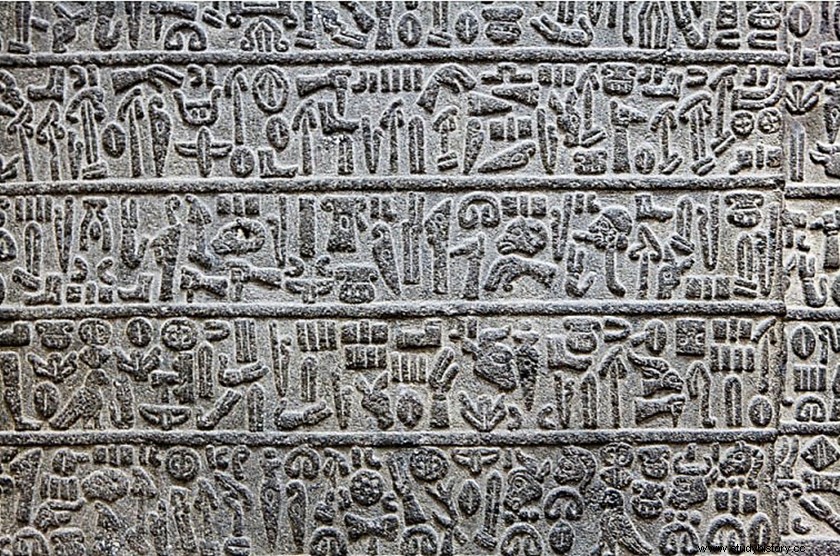
At the beginning of the II millennium BC, the heart of Asia Minor (present-day Turkey) will see the birth of one of the most important empires in ancient history. The Hittites, to whom they attribute important advances such as being the first to dominate the elaboration of tools and weapons with iron, without a doubt this element made them one of the most important armies of the Ancient World. They developed advanced battle systems based on their famous war chariots, but they also became, together with the Egyptians, pioneers in the art of the pact, when both empires agreed on the well-known Kadesh treaty , the oldest in history.
Phases in the history of the Hittites.
In the year 2000 BC, a series of nomadic peoples begin to settle in the center of the Anatolian Peninsula, which at that time was inhabited by the hatti . Among the newcomers, the Luwitas stand out. , palaitas and neitas, all three have in common the so-called Indo-European origin, that is, the wide spectrum of nomadic peoples who roamed the steppes, from the Indian subcontinent to Eastern Europe. After these settlements, the small traditional city-states of the Ancient World will arise, and around the year 1,800 BC, they begin to enter into various conflicts among themselves, seeking supremacy in the area.
Old Kingdom, 1750-1500 BC.
According to the written sources of her Assyrian neighbors, Annita, descendant of the people of the Nesites, he subdued the rest of the peoples of the area to become the first king of the Hittite Empire. If at first they became vassals of the Assyrians, the decline of the latter soon led them to become the strongest power in the area. At first they placed the capital of the empire in Kültepe, territory of the Nesites, because the capital and main commercial center of the Hatti area, Hattussa, was burned down by King Annita.

Recreation of the city of Hatussas
All the dates that appear from this period are confusing, but according to the Rescript of Telepinu , the oldest Hittite source, a series of kings ruled between the XVII-XVI centuries BC, in the Hittite territories. The first three, Labarna I, Hatussil I and Mursil I, became the great conquerors of the territories of the Anatolian Peninsula, until they were able to unite the Black Sea and the Mediterranean Sea under the designs of the same king. But after the conquests, internal problems followed one another, access to power became a continuous bloodbath between the candidates of strange succession lines, protected by the plans of the Hittite nobility.
It would not be until the end of this first period, when the king Telepinu I , who ruled between approximately 1525-1500 BC, brought some order to the internal politics of the Hittite Empire. The nobility was excluded from the lines of succession, incorporating a clear line of succession within the royal family. To satisfy the warrior aristocracy, different political groups were created, such as a General Assembly of citizens called Panku , next to it, highlight Tribunal de Justicia , that its most important task was to ensure compliance with the laws of royal succession.
New Kingdom, 1450-1336 BC.
Despite laying the foundations of a strong empire, after the death of Telepinu I a series of kings of little relevance succeeded one another. In addition, it coincided with a period of splendor for its geographical rivals, Egypt under the reign of Thutmose III, and a consolidated kingdom of the Mitanni, which acted as a buffer between the two great empires in the area, the Egyptians and the Hittites. Therefore, it was necessary to wait for the arrival of a more powerful king to continue the conquering path. Tudhaliya he was the first of this list of kings of the New Kingdom, among his achievements was the conquest of the Syrian city of Aleppo.

The gate of the lions of Hatussas, the capital of the Hittite Empire.
Around 1380 BC, the king who will lead the Hittite Empire to the highest level of power comes to power. Suppiluliuma I , which will govern the destinies of the empire for nearly half a century. The first years of his reign were dedicated to suppressing internal revolts and preparing his conquest expeditions. This period is known as “the three Syrian wars ”.
The enemies of the Hittites were their two neighbors, Mitanni and Egypt, and the union of both increased their strength. So Suppiluliuma I decided to take advantage of the fact that the religiously obsessed Amenophis IV reigned in Egypt, in order to attack the positions that Mitanni had in the Syrian territories. The early campaigns quickly favored the Hittites with new armies mixed with cavalry and fast two-horse charioteers. They soon conquered Aleppo and Kadesh again, a real key communications hub in the control of the eastern Mediterranean. But the difficult thing was to maintain the positions the following years, the continuous coalitions between the locals and the Mitanni led the Hittites to redouble their efforts to maintain the area. Although they even managed to increase it during the second campaign, reaching Damascus and seriously endangering access by land to the ports of Byblos and Ugarit in Egyptian hands.
Only the plague, as related by tablets from the period of one of Suppiluliuma I's successors, specifically Mursil II, stopped the Hittite aspirations from reaching Egypt. What he did achieve was to reduce the Mitanni territories to practically the surroundings of his capital, Wassukanni, leading the Mitanni Empire to its virtual disappearance in the following years. But this Hittite victory will soon turn against him, as it is used by Mitanni's neighbors, the Assyrians, to be reborn and return to the forefront of the fight for the territories to the northwest, the fertile crescent.
Suppiluliuma I's successors.
Approximately a century, the Hittites lasted the conquered territories, despite the great enemies they had to face. In the first place, to the Egyptians who, after the arrival of the XIX Dynasty, recovered their warrior spirit, mainly with Seti I and the everlasting Ramses II, the oldest pharaoh in Egypt.

The Battle of Kadesh
During this period one of the most famous battles in ancient history took place. In the year 1274 BC, the armies of Ramses II and Muwattali clashed in Kadesh, 40,000 Hittites with 3,700 war chariots against 16,000 Egyptians with 2,000 chariots. Despite the Egyptian disadvantage, the result has always been considered "in a draw", neither of the two armies clearly subdued the other neither in the battle of Kadesh, nor in the following years, keeping the border between the two empires in the same place. This aspect is reflected in the later treaty of Kadesh, celebrated precisely in the same place of the battle, but fifteen years later, 1259 BC. This treaty presented us with two peoples in low hours, who had to agree to defend themselves from a common and superior rival, Assyria.
If Egypt managed to avoid its end, the same did not happen with the Hittites. Of the last kings of the 13th century BC, we know little more than their names, the last curiously had the same name as the greatest king in the history of this town; If Suppiluliuma II tried to imitate his remote ancestor, he succumbed in the attempt. In front of the Hittites great Assyrian kings like Shalmaneser I or the great Tukulti-Ninurta I, but even so we can say that his end came from the hand of one of the mysteries of ancient history, about the year 1,200 BC, with the arrival of the so-called peoples of the sea. I invite you to get to know them a little better in the following article:the-peoples-of-the-sea
What were the Hittites like?
After knowing some of the most important details of their history, we cannot miss the opportunity to get to know them a little better. His knowledge comes from the libraries of his Assyrian and Egyptian neighbors, but above all from his great Royal Archives of Boghazköy, found in the vicinity of his ancient capital Hattussa.

Yazilikaya the most important religious sanctuary of the Hittite Empire
- In its political structure we find certain differences with its rivals and neighbors, we can say that the Hittite Empire was a union of several states supported by a central one, which was governed by the king. The figure of the latter was the political apex of the state, and despite the fact that we cannot consider it as absolutist, since it was elected by the Assembly of Notables, in practice over the course of its history the classic features of this type of monarchy were were accentuating in the Hittite monarchs. They became leaders of the armies and supreme judges, also after their death they were worshiped as one more god of the Hittite pantheon. Beside his main wife served as queen mother of the state, and finally highlight the figure of the young crown prince elected by the Assembly of Notables and incorporated after the designation to the tasks of government of the state.
- The society Hittite was constituted by monogamous families, only the kings and the high dignitaries of the state were allowed to practice polygamy. The hereditary line in families was male, and daughters had to be endowed before marriage. Note that, in a warrior society like the Hittite, recruitment was essential, so among men, military service was mandatory.
- Thereligion of the Hittites, as it could not be otherwise, it was polytheistic and of Mesopotamian tradition. As in the rest of the ancient world, religion interfered in the political and social life of the Hittite people. Mean that their main gods were Wurusumu , the solar goddess, and her husband Teshub , storm god. From both, the rest of the great pantheon of gods emerged, these numbered in the hundreds. Throughout the empire the construction of great places of worship spread, such as Yazilikaya near Hatussa. These served the kings as an escape from their supposed place next to the gods. In them, the most diverse festivities and religious celebrations were celebrated, the most important, the Purullu, was carried out after the rigorous winter, waiting for the great rains that should provide splendid harvests.

Hittite hieroglyphics.
- The writing as an essential part of the ancient world, it was practiced by the Hittites since their gestation as a society. In the royal archives of Boghazköy, two different ways of writing have been found, an older one based on cuneiform writing and a more recent second from approximately the New Kingdom based on Hittite hieroglyphs, by the way, very different from those of their Egyptian neighbors. Both scripts served them to express themselves in different languages or dialects, including those of their hometowns, that is, the Luwitas or Nesitas. In religious celebrations, a dead language such as Sumerian was used, and in official documentation or international correspondence, the language par excellence of the Near East, Babylonian.
More info:
The Empires of the Ancient East, Elena Cassin, 2005
History of the ancient world, Ana Mª Vázques Hoys, Ed. Sanz y torres, 2007
arrecaballo.es
